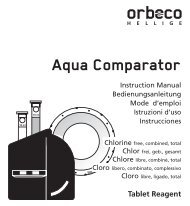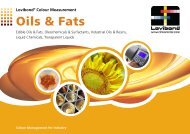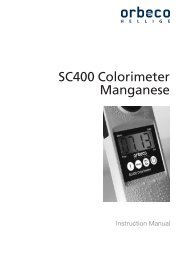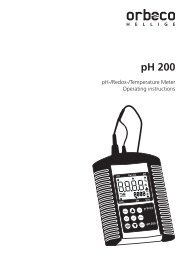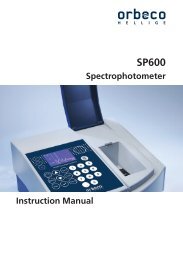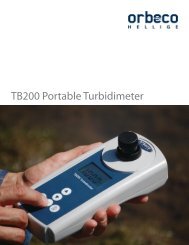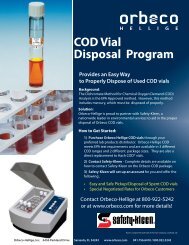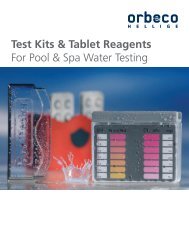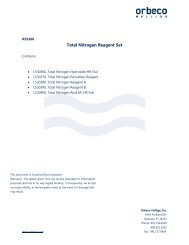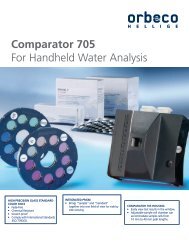Legionella Systems Test Kit Manual - Orbeco-Hellige
Legionella Systems Test Kit Manual - Orbeco-Hellige
Legionella Systems Test Kit Manual - Orbeco-Hellige
You also want an ePaper? Increase the reach of your titles
YUMPU automatically turns print PDFs into web optimized ePapers that Google loves.
<strong>Test</strong> Procedure<br />
Fit Sample Point<br />
Identify the water system to be sampled and an appropriate location from which to obtain a representative<br />
sample. Large systems may need to be sampled and tested at multiple locations. Attach the sample point<br />
adapter to the point in the system to be tested. It is recommended that a sample point adapter be fitted and<br />
retained to each sample point to avoid cross contamination. The sample line pressure should not exceed 6<br />
bar (87 psi).<br />
Take the Sample<br />
Before taking the sample, flush the sample port for 15 seconds. Attach the filter to the sample point adapter;<br />
push the open end of the filter into the plastic luer fitting and twist the locking ring to secure. Hold the sample<br />
collection bottle under the outlet port of the filter.<br />
Open the system valve to allow the filtration to start, filter 250 ml of the water and close off the valve.<br />
If the sample takes longer than 10 minutes to filter, then stop the filtration process and measure the amount of<br />
liquid in the collection bottle before proceeding to the next step (the detection limit will be affected, se Limit of<br />
Detection section).<br />
Resuspend the Bacteria<br />
Disconnect the filter from the sample point adapter by twisting the lock ring and pulling the filter from the fitting.<br />
Remove the white screw cap from the filter and replace it on the opposite end of the filter.<br />
• Pull the syringe back to the 0.5 ml mark to suspend the recovery buffer, then push the syringe all<br />
the way to the 0 ml mark.<br />
• Repeat this process two (2) additional times.<br />
• Draw the syringe back to collect 0.1 ml of sample, then disconnect from the filter. The syringe<br />
now conains the recovered bacteria ready for testing.<br />
Add Sample to the <strong>Test</strong> Strip<br />
Remove the test from its foil wrapping, and place the test on a flat surface.<br />
The foil wrapping should not be opened until immediately prior to running the test. If the foil is opened and<br />
then the test is not performed within 60 minutes, discard the test.<br />
Before use, the test should have 2 pale blue lines across the result window. If these are not present, notify your<br />
supplier to replace the test kit. Take the pipette from the foil wrapping.<br />
Place the syringe over the small sample window at the end of the test strip, and press the plunger so that 0.1 ml<br />
of sample is dispensed onto the test strip. Record the time.<br />
Read the <strong>Test</strong> Strip<br />
Leave the test strip sitting on a flat surface during incubation. For optimum results the test results should be<br />
performed at room temperature. After waiting 25 minutes, examine the test strip in good lighting. If the<br />
test is not read within 60 minutes of adding the water sample, it should be discarded and a new test should be<br />
run. The test should show one of the following results on the large result window on the test strip:<br />
Negative Result: One (1) RED line across the result window at the end furthest from the sample window.<br />
Positive Result: Two (2) RED lines across the result window. The red line closest to the sample window may<br />
be very faint (pale pink). Any distinct line, no matter how faint, should be counted as positive.<br />
Invalid Result: If the test does not show any red lines; or if it only shows a line at the end closest to the sample<br />
window; or if the line furthest from the sample window is very faint, then the test is invalid. Repeat the test and<br />
notify your supplier for technical support.



